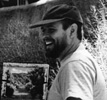
David Ballew is a perennial student who integrates the lessons of various art forms into his paintings. From poetry to philosophy to meditation, Ballew sees these vehicles as similar in essence and integral to his painting process.
Born in Hartford, Connecticut in 1955, David Ballew has always felt a sense of awe at the nature surrounding him. He recalls a boyhood fishing trip, in which his father handed him a fishing rod with a large fish struggling in the water at the end of the line. Unable to reel in the large fish, Ballew instead gained an early sense of the mysterious. Long a student of philosophy, Ballew says that he will be playing with mystery for the rest of his life through his paintings. His years of meditation have also served him as a painter. Ballew approaches painting with great respect and gives his full attention to the process of creation. He is constantly refining his skills, painting six days a week, often en plein air. Many people, including artists, writers and spiritual teachers have influenced Ballew. He spends as much time as he can with artists he admires, including Irby Brown, George Carlson, Michael Lynch, Mark Daily and Ned Jacob. He often quotes poets and philosophers. On the back of each of his paintings, he always includes a verse penned in his own calligraphy. Over time, he has come to realize that his art teachers and meditation teachers have been teaching many of the same lessons. Learning the “language” of painting is an eloquence that Ballew strives for. Ballew also has an affinity for Chinese and Japanese art. Their emphasis on spaciousness and simplicity have influenced his landscapes. Eastern literature has also been central to Ballew’s education, especially koans and haiku. Ballew likens their intuitive and emotional qualities to what he experiences while painting.Continuing the tradition that Chinese and Japanese artists have employed for centuries, Ballew has a signature seal that he stamps to his work. His is the ginkgo leaf, which still appears the same on trees today as it does in fossils from the end of the last dinosaur age. Ballew feels that paintings are like fossilized impressions that remain after an artist passes through.Always studying and pushing himself as an artist, Ballew believes that he could spend the next several decades perfecting his art without achieving anywhere near what he sees as possible. As a Sufi teacher once said, “The purpose of life is like the horizon: when you reach the point you’ve been aiming for, a whole new vista opens up.”